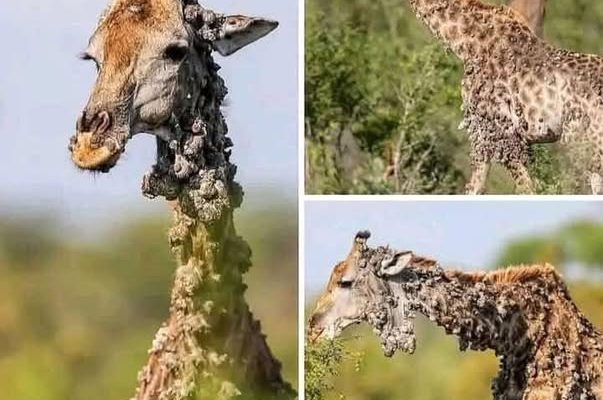Most people who celebrate their 40th anniversary might choose a cruise or a beach vacation — but for the South African couple Marius and Michelle Nortje, nothing compares to a trip into the wild.
Their love story, which has lasted for four decades, was about to take an unforgettable twist deep within Kruger National Park.
What began as a normal drive turned into a moment that the couple — and soon the internet — would always remember.
“We go at least once a year, but sometimes as many as four times,” Marius shared in an interview with The Citizen.
However, during their anniversary trip last December, something amazing appeared from the bushes: three giraffes. One of them was something Marius, a skilled wildlife photographer, had never seen before.
“We couldn’t find [the lions] on the tar road and decided to take a gravel road when we first spotted one and then two giraffes coming out of the bushes. When the third giraffe showed up, we noticed strange growths all over her body,” he remembered.
Quickly, Marius took pictures of the giraffe and later posted them on Facebook, where they quickly sparked both curiosity and concern.
“People were curious if she was in pain,” he said. “But she was eating calmly, and it didn’t seem to bother her, even though it looked painful.”
He also tagged the South African National Parks (SANParks) in his post to raise awareness, but at the time of the interview, he hadn’t received a reply yet.
A rare condition
The giraffe’s pictures became even more popular after WorldWide Vets, a global animal welfare group, shared them. Dr. Gemna Campling, who started and leads the organization, mentioned that the giraffe is dealing with a problem caused by a type of papillomavirus.
“There are various kinds of papillomavirus, and each one affects a different species. The cow version, known as Bovine Papillomavirus or BPV, is thought to be the one affecting this giraffe,” Dr. Campling said.
She explained that the virus spreads through direct contact, which in this case is probably through oxpecker birds.
“In this situation, it seems that oxpecker birds land on the giraffe and peck at the parasites that naturally live on it, spreading the virus from one animal to another. The rest of the herd appears to be fine, except for this one giraffe, similar to what has been seen before with this disease.”
Even though the disease might look alarming, it is not fatal.
“Many instances of BPV resolve on their own, and the animal can fully recover,” Dr. Campling stated. “There is no specific treatment for this disease in giraffes, and wildlife veterinarians are keeping a close watch on the situation. Fortunately, this type cannot be transmitted to humans, although there is a Human Papilloma Virus that affects people.”
However, Gemma Campling added, “While it is not a life-threatening illness, it certainly causes discomfort when the lumps become as severe as this.”
It’s tough to know exactly how much pain the giraffe is experiencing, but it’s sad to think she has to endure this. Even with the visible lumps, she was peacefully eating grass, appearing unaffected by her condition. Nevertheless, the images moved many people online, creating a wave of empathy, curiosity, and wonder from thousands of viewers.
For Marius and Michelle, it was a powerful reminder of why they keep returning to the wild.
Sometimes, the most unforgettable moments come when you’re not looking for them. And sometimes, it takes the lens of one devoted nature lover to remind the world just how resilient — and vulnerable — wildlife can be.



